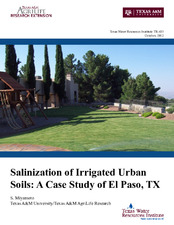| dc.description.abstract | This study was conducted to assess soil salinity levels in large landscape areas, such as golf courses, parks, and school grounds which were developed on various soil types in El Paso, Texas. The survey encompassed the East, the Central, the Northwest, and the Upper and Lower Valleys, covering 16 fairways at seven golf courses, 37 city parks, 30 school grounds, and 13 apartment landscapes on the Westside. The highest soil salinity (6 to 11 dS m-1) was found in the clayey soils of the Upper and Lower valleys, even when water of low salinity (650 to 750 ppm) had been used for irrigation. Spadoratic soil salinization was also observed in loamy soils of the South Central irrigated with city potable water, and topdressed soils of the Northwest after conversion to reclaimed water. Soil salinization was not observed in deep sand along I-10, and seldom in sandy calcic soils in the East and North Central, even though these soils contain a layer of caliche. Soil types play a role on soil salinization as much as does water quality. | en |


